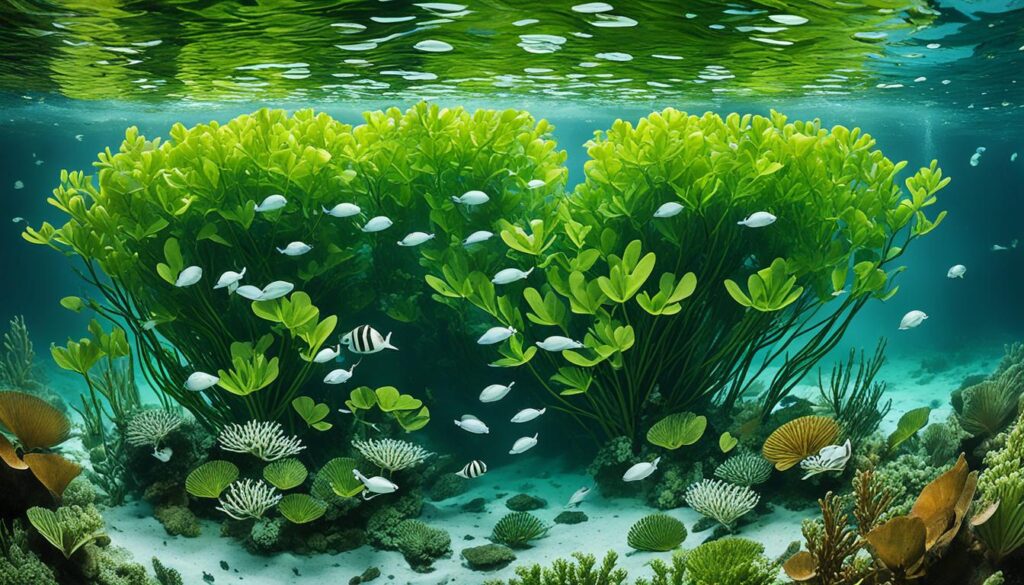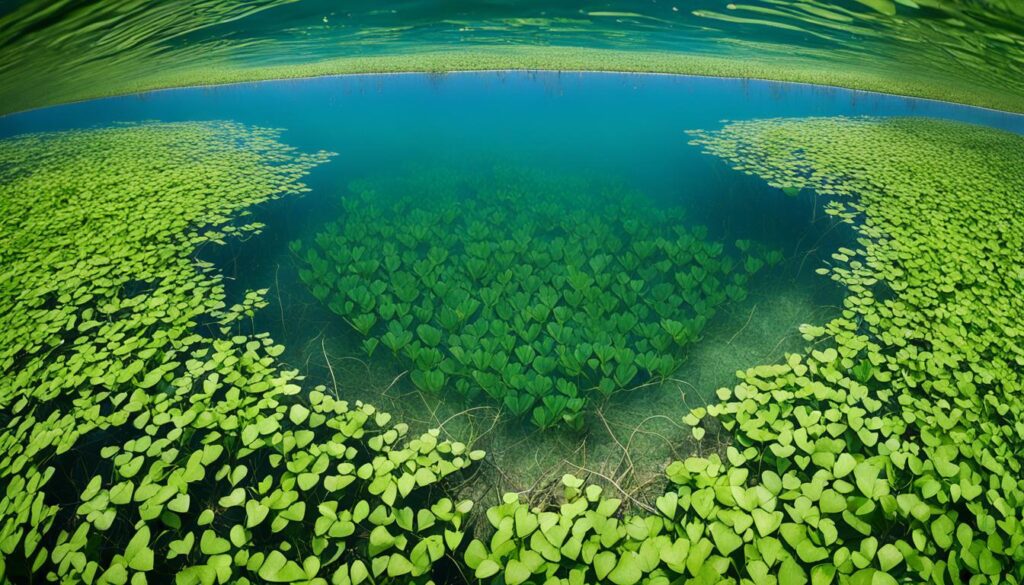As an avid admirer of Florida’s diverse aquatic ecosystems, I am deeply concerned about the growing presence of Floating Heart, an invasive aquatic plant species wreaking havoc on our pristine waters. The rapid spread of this non-native plant has raised alarms among environmentalists and wildlife experts, and urgent action is needed to mitigate its detrimental effects.
Floating Heart (Nymphoides cristata), with its striking yellow flowers and heart-shaped leaves, may initially captivate your attention. However, it’s crucial to recognize that this seemingly delicate beauty is a formidable threat to Florida’s native aquatic plants and the delicate equilibrium of our underwater ecosystems.
The distribution of Floating Heart has been steadily increasing in Florida’s waterways, thanks to its ability to thrive and outcompete native plant species. Its rapid growth forms dense mats on the water’s surface, choking out sunlight and hindering oxygen exchange, which can have severe consequences for aquatic life.
In this article, I will delve into the characteristics and distribution of Floating Heart in Florida, illuminating its environmental impact on native aquatic plants and underscoring the perils it poses to marine life. I will also delve into the management strategies employed to control this invasive species and the inspiring collaborative efforts between government agencies and environmental organizations to address this pressing issue, instilling a sense of hope for the future of our aquatic ecosystems.
Angler’s Essentials:
- Floating Heart, an invasive aquatic plant species, is posing a threat to Florida’s waters.
- It outcompetes and displaces native aquatic plants, disrupting the delicate balance of underwater ecosystems.
- The dense mats of Floating Heart can negatively impact fish, crustaceans, and other aquatic organisms.
- Management strategies, both mechanical and chemical, are employed to control and eradicate Floating Heart.
- Collaborative efforts between government agencies and environmental organizations are underway to address this issue.
Understanding Floating Heart: Characteristics and Distribution
As we continue our exploration of Floating Heart, we must delve deeper into its characteristics and distribution within Florida’s waterways. This invasive aquatic plant species, scientifically known as Nymphoides cristata, has gained significant attention due to its rapid expansion and detrimental impact on native aquatic plants.
Floating Heart is a non-native aquatic plant species that originated from Asia. It is recognizable by its heart-shaped leaves that float on the water’s surface, displaying beautiful yellow flowers during its blooming season. This distinctive appearance adds to its appeal and contributes to its ability to establish and spread quickly.
Nymphoides cristata has found a favorable environment in Florida. It thrives in slow-moving or stagnant freshwater systems like lakes, ponds, and canals. The plant is a formidable invader due to its ability to adapt to diverse environmental conditions and reproduce rapidly.
One of the main reasons behind the success of the Floating Heart is its efficient reproductive capabilities. The plant reproduces sexually through the production of seeds and asexually through vegetative propagation. This dual method allows the Floating Heart to rapidly colonize new areas and establish dense mats on the water’s surface.
These dense mats of Floating Heart pose a significant threat to native aquatic plants by blocking sunlight and lowering oxygen levels in the water. This invasive plant deprives native species of the necessary resources for growth and survival, ultimately leading to their displacement and loss of biodiversity in affected areas.
“The rapid growth and spread of Floating Heart can have devastating consequences for the delicate balance of underwater ecosystems in Florida.”
The distribution of Floating Heart in Florida’s waterways is extensive and continues to expand. This invasive plant was reported in several Florida counties, including Miami-Dade, Broward, Palm Beach, and Orange. Efforts to prevent its spread and manage its impact are ongoing, but the challenges presented by this invasive species are significant.
To provide a clearer understanding of Floating Heart’s distribution, here is a table highlighting the presence of this invasive aquatic plant in different counties across Florida:
| County | Presence of Floating Heart |
|---|---|
| Miami-Dade | Yes |
| Broward | Yes |
| Palm Beach | Yes |
| Orange | Yes |
This table highlights the widespread distribution of Floating Heart in various counties across Florida, indicating the urgent need for invasive aquatic plant management and control strategies to protect the state’s valuable water resources.
Now that we have a better understanding of the characteristics and distribution of Floating Heart, the next section will focus on the environmental impact of this invasive species on native aquatic plants.
Environmental Impact of Floating Heart on Native Aquatic Plants
Floating Heart, an invasive aquatic plant species in Florida, poses significant environmental threats to the native aquatic plants that inhabit the state’s waters. As this aggressive plant spreads and establishes its presence, it outcompetes and displaces native plant species, disrupting the delicate balance of underwater ecosystems.
The rapid growth of Floating Heart forms dense mats on the water’s surface, blocking sunlight from reaching submerged plants below. This reduction in light availability impacts the photosynthesis process of native aquatic plants, hindering their growth and survival. Over time, the lack of sunlight leads to the decline or complete eradication of these crucial underwater vegetation communities.
“The aggressive nature of Floating Heart allows it to outcompete native aquatic plants, monopolizing resources such as nutrients, space, and sunlight,” says Dr. Sarah Thompson, a renowned aquatic biologist. “This displacement not only disrupts the natural habitat, but also diminishes the food and shelter available for various aquatic organisms.”
Furthermore, Floating Heart’s dense mats create an oxygen-depleted environment beneath them. The shading effect prevents the diffusion of oxygen into the water, adversely affecting the survival of fish, invertebrates, and other organisms that depend on well-oxygenated waters. The reduction in oxygen availability can lead to stress, suffocation, and even death for these vital members of the aquatic ecosystem.
To mitigate the environmental impact of Floating Heart on native aquatic plants, effective aquatic weed control and underwater plant eradication measures are essential. Implementing strategies such as mechanical removal, hand-pulling, and targeted herbicide application can help reduce the dominance of Floating Heart and restore native plant populations.
Comparison of Floating Heart and Native Aquatic Plants
| Characteristics | Floating Heart | Native Aquatic Plants |
|---|---|---|
| Growth Rate | Rapid | Varies by species |
| Competition Ability | High | Dependent on habitat conditions |
| Light Requirement | Tolerates shade, reduces light for submerged growth | Varies by species, requires adequate sunlight for photosynthesis |
| Oxygen Production | Minimal due to dense floating mats | Significant, contributes to overall ecosystem oxygen levels |
By understanding the environmental impact of Floating Heart on native aquatic plants, we can take proactive steps towards preserving and restoring the health of Florida’s water ecosystems. Effective aquatic weed control measures, combined with ongoing monitoring and restoration efforts, are vital to protecting the biodiversity and ecological balance in our waterways.
Stay tuned for the upcoming sections where we explore the threats posed by Floating Heart to aquatic life and the management strategies employed to combat this invasive species.
Threats Posed by Floating Heart to Aquatic Life
Floating Heart, one of the invasive aquatic plants in Florida, poses significant threats to the diverse range of aquatic life that inhabit the state’s waterways. The dense mats formed by this non-native species have detrimental effects on fish, crustaceans, and other organisms, impacting their survival and overall ecosystem health.
One of the primary threats that Floating Heart poses to aquatic life is the reduction of oxygen levels. The dense mats block sunlight from reaching the water’s surface, limiting photosynthesis and the production of oxygen by underwater plants. As a result, fish and other organisms dependent on oxygen struggle to survive in these oxygen-depleted environments.
The dense coverage of Floating Heart also hinders movement, making it difficult for fish to swim and access food sources. The restricted swimming areas and limited access to prey can lead to malnourishment and reduced growth rates among fish populations. Additionally, the presence of Floating Heart can disrupt the feeding habits and natural behaviors of aquatic organisms, further impacting their overall health and reproductive success.
Furthermore, the dense mats of Floating Heart provide a conducive environment for undesirable insect populations. Mosquitoes, for example, find ideal breeding grounds within these floating mats, increasing the risk of mosquito-borne diseases for both aquatic life and nearby communities. The proliferation of insects can disrupt the delicate balance of the ecosystem, potentially leading to the decline of native species.
“The presence of Floating Heart** in Florida’s waterways calls for effective management strategies to minimize these threats and restore the health of aquatic ecosystems. Aquatic plant removal services, specializing in waterway invasive plant control, play a crucial role in combating the spread of Floating Heart and mitigating its impact on aquatic life. These services employ a combination of mechanical and chemical methods to remove and control the invasive plant while minimizing harm to native species.”
“Waterway invasive plant control is vital to preserving the delicate balance of Florida’s underwater ecosystems and safeguarding the diverse range of aquatic life that calls these habitats home. Through collaborative efforts and the expertise of aquatic plant removal services, we can take proactive steps to manage and restore the health of our waterways.”

| Threats Posed by Floating Heart to Aquatic Life | Impact |
|---|---|
| Reduction of oxygen levels | Impairs respiration and survival of aquatic organisms |
| Restricted swimming areas and limited access to food sources | Causes malnourishment and reduced growth rates in fish populations |
| Disruption of feeding habits and natural behaviors | Impacts overall health and reproductive success of aquatic organisms |
| Proliferation of insects, such as mosquitoes | Increases the risk of mosquito-borne diseases and ecosystem disruption |
Management Strategies for Floating Heart Invasive Florida Aquatic Plants
Controlling and eradicating Floating Heart in Florida’s waterways requires a combination of mechanical and chemical methods. These management strategies aim to restore the balance of underwater ecosystems and prevent further spread of this invasive aquatic plant.
It is crucial to implement effective strategies to manage Floating Heart and protect native aquatic plants from its detrimental effects. By doing so, we can preserve the diversity and health of Florida’s waters.
- Mechanical Methods: Mechanical methods involve physically removing Floating Hearts from water bodies. This can be done through manual hand-pulling, cutting, or using specialized machinery such as aquatic weed harvesters. By physically removing the plants, mechanical methods help reduce their population and prevent their spread.
- Chemical Treatments: Chemical treatments are often used with mechanical methods to control Floating Heart. Herbicides specifically designed for aquatic environments are applied to targeted areas to kill or inhibit invasive plant growth. Using these chemicals with caution is important to minimize their impact on other aquatic organisms.
Ongoing Restoration Efforts
Florida aquatic plant restoration programs are actively working to combat the spread of Floating Heart and restore the native ecology of affected waterways. These restoration efforts focus on implementing sustainable and environmentally friendly management strategies.
A key component of restoration programs is monitoring and assessment, which helps evaluate the effectiveness of management strategies. By closely monitoring the response of floating heart populations and the recovery of native plants, restoration teams can adapt their approaches to achieve optimal results.
Collaboration among government agencies, environmental organizations, and local communities is essential for successful management and restoration. By pooling resources, knowledge, and expertise, these stakeholders can work together to address the challenges posed by Floating Heart and other invasive aquatic plants.

| Management Strategies | Advantages | Disadvantages |
|---|---|---|
| Mechanical Methods | – Direct removal of Floating Heart – Can be selective and targeted – Minimal environmental impact | – Labor-intensive – May require specialized equipment – Regrowth potential if not thorough |
| Chemical Treatments | – Effective in reducing Floating Heart populations – Broad coverage – Can be applied in hard-to-reach areas | – Potential harm to non-target organisms – Requires expertise in handling and application – Regulatory restrictions |
Collaborative Efforts in Invasive Aquatic Plant Management
Addressing the challenges posed by Floating Heart and other invasive aquatic plants requires a collective effort. Government agencies, environmental organizations, and local communities in Florida have joined forces to implement effective strategies and initiatives for invasive aquatic plant management. Through collaborative endeavors, these stakeholders are making significant progress in restoring and preserving the state’s waterways.
Successful Programs and Initiatives
One exemplary program is the Florida Aquatic Plant Management Society (FAPMS), a nonprofit organization that brings together professionals and stakeholders dedicated to managing invasive aquatic plants. FAPMS is crucial in promoting knowledge sharing, research, and the development of innovative solutions in Florida.
The Florida Fish and Wildlife Conservation Commission (FWC) also takes an active part in managing invasive aquatic plants. FWC conducts comprehensive surveys to monitor the spread of invasive species and collaborates with local communities to implement control measures. Their efforts are aimed at minimizing the impact of invasive plants on native wildlife and ecosystems.
Local community involvement is vital in invasive aquatic plant management. Public education programs, volunteer initiatives, and citizen science efforts empower individuals to contribute to restoring Florida’s waterways. Through grassroots campaigns and outreach activities, communities raise awareness about the detrimental effects of invasive plants and encourage responsible practices to prevent their spread.
By uniting their expertise, resources, and passion, government agencies, environmental organizations, and local communities are creating a formidable force against the threat of Floating Heart and other invasive aquatic plants. Together, they are actively safeguarding Florida’s waterways for future generations to enjoy.
Coordinated Approaches and Partnerships
Collaboration extends beyond local communities and involves partnerships with universities, research institutions, and other states facing similar challenges. Stakeholders can develop comprehensive management strategies and optimize invasive plant control efforts by sharing knowledge and lessons learned.
Adopting integrated pest management (IPM) approaches is another significant milestone in collaborative invasive aquatic plant management. IPM combines various control methods, including mechanical, chemical, and biological interventions, to effectively manage invasive plant populations while minimizing environmental impact.
Furthermore, collaborative efforts are instrumental in securing research, monitoring, and restoration funding. By leveraging partnerships and engaging with policymakers, stakeholders can advocate for increased resources dedicated to invasive aquatic plant management and restoration initiatives.
Benefits of Collaboration
Collaborative invasive aquatic plant management fosters a holistic approach to address the challenges posed by Floating Heart and other invasive species. By pooling diverse perspectives, expertise, and resources, stakeholders achieve greater efficiency and effectiveness in managing and restoring Florida’s waterways.
Through collaboration, stakeholders can enhance preventive measures, implement targeted control strategies, and sustain long-term restoration efforts. By investing in collaborative approaches, Florida is establishing a solid foundation for preserving its unique and fragile aquatic ecosystems.
| Benefits of Collaborative Efforts | Examples |
|---|---|
| Knowledge sharing and research | Florida Aquatic Plant Management Society (FAPMS) |
| Comprehensive surveys and monitoring | Florida Fish and Wildlife Conservation Commission (FWC) |
| Public education and awareness | Local community initiatives |
| Partnerships and collaborations | Universities, research institutions, and other states |
| Integrated pest management | Mechanical, chemical, and biological interventions |
| Advocacy and securing funding | Policymakers and stakeholder engagements |
Conclusion
Throughout this article, we have explored the threat posed by Floating Heart, an invasive aquatic plant species, to Florida’s waters. We have discussed its characteristics, distribution, and environmental impact on native aquatic plants. Additionally, we have highlighted the threats it poses to aquatic life and examined various management strategies employed to control its spread.
Managing invasive aquatic plants like the Floating Heart is crucial for preserving Florida’s fragile ecosystems. Effective invasive aquatic plant management and waterway invasive plant control are essential to maintaining the ecological balance of our waters and protecting native species.
We can implement targeted removal efforts and restore affected areas by understanding invasive plant species’ characteristics and distribution patterns like Floating Heart. Ongoing collaborations between government agencies, environmental organizations, and local communities play a vital role in combatting these invasive species and ensuring the long-term health of our waterways.
In conclusion, we must continue our efforts in invasive aquatic plant management and waterway invasive plant control to mitigate the impact of species like Floating Heart. By doing so, we can preserve Florida’s waters’ biodiversity and ecological integrity, safeguarding them for future generations.
FAQ
What is Floating Heart?
Floating Heart (Nymphoides hydrophylla) is an invasive aquatic plant species that poses a threat to Florida’s waters. It is a floating plant with heart-shaped leaves and vibrant yellow flowers.
How does Floating Heart spread in Florida’s waterways?
Floating Heart spreads primarily through fragments or seeds carried by water movement, boats, and wildlife. These plant fragments can establish new colonies and rapidly reproduce, leading to the plant’s rapid expansion.
What is the impact of Floating Heart on native aquatic plants?
Floating Heart outcompetes native aquatic plants by forming dense mats, blocking sunlight from reaching other submerged vegetation, and depleting oxygen levels. This displacement disrupts the ecological balance of underwater ecosystems and affects biodiversity.
What threats does Floating Heart pose to aquatic life?
The dense mats of Floating Heart can negatively impact fish, crustaceans, and other aquatic organisms. By reducing oxygen levels and blocking sunlight, these mats disrupt the natural habitat and feeding patterns of various species.
How is Floating Heart managed and controlled in Florida’s waterways?
There are various management strategies employed to control and eradicate Floating Heart. These include mechanical methods such as cutting and harvesting, as well as chemical treatments using herbicides. Ongoing restoration efforts also focus on reintroducing native plants to restore balance.
What collaborative efforts exist in invasive aquatic plant management?
Government agencies, environmental organizations, and local communities collaborate to address the issues caused by Floating Heart and other invasive aquatic plants. These collaborations involve sharing resources, funding research, and implementing programs for invasive plant control and restoration.
